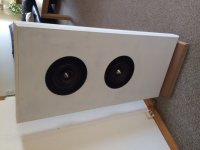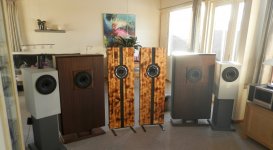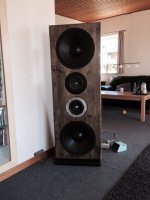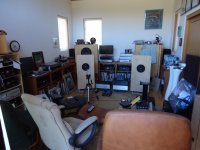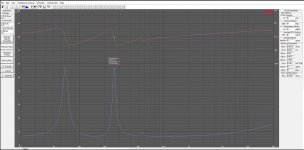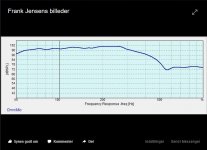I have been experimenting with this unit for some years now. As mentioned, it is designed for open baffles.
But I find that it can be used in other configurations as well, depending what you want and need. When used in a small closed box, it does have a small peak at low frequency’s. But if this is taken in consideration and placed far from the back wall, it doses preform pretty well.
I have tried a larger box with stuffing, but with no back plate (open in the back), that is even greater. So, the idea about using an aperiodic design, sounds like a good idea.
Another design I have tried is an open baffle using two units. The unit no. two is cross over at the frequency where the baffle starts to influence the respond. This works amazing, the respond is almost one oct lower, when using a proper second unit.
I have posted some pictures for inspiration.
But I find that it can be used in other configurations as well, depending what you want and need. When used in a small closed box, it does have a small peak at low frequency’s. But if this is taken in consideration and placed far from the back wall, it doses preform pretty well.
I have tried a larger box with stuffing, but with no back plate (open in the back), that is even greater. So, the idea about using an aperiodic design, sounds like a good idea.
Another design I have tried is an open baffle using two units. The unit no. two is cross over at the frequency where the baffle starts to influence the respond. This works amazing, the respond is almost one oct lower, when using a proper second unit.
I have posted some pictures for inspiration.
Attachments
Nice to see what you're using Frank, and so neat too.
Here's my listening room a couple days ago.
😛
I have a solution for that peak in sealed boxes, which is a nice negative
output impedance on the amplifiers. A DF of -5 or so just about does it...
Here's my listening room a couple days ago.
😛
I have a solution for that peak in sealed boxes, which is a nice negative
output impedance on the amplifiers. A DF of -5 or so just about does it...
Member
Joined 2009
Paid Member
This cross-section of the PR200 (an advanced aperiodic box) gives some ideas on this approach.
remarkably similar to the BOFFLE isn't it.
Looking good, sir. Love that room 🙂
Baffles look great and I like the black line-level chassis.
The Xenomorph is cool too.
Baffles look great and I like the black line-level chassis.
The Xenomorph is cool too.
Frank,
Welcome to your thread. Very nice to have you around, and those experiments you've done look quite interesting...
Welcome to your thread. Very nice to have you around, and those experiments you've done look quite interesting...
Does anyone have a free-air impedance curve of the SAL driver? (Not just the bass peaks in the Nelon Pass Youtube video...) A figure covering DC to daylight would be nice, and raw data would be even nicer.
Here's the SAL driver part of Nelson's 2015 BAF talk for anyone who hasn't checked it out yet. You can download the slides from there as well.
BAF Presenter Nelson Pass - YouTube
BAF Presenter Nelson Pass - YouTube
Looks like the transition from pistoic behaviour to resonant behaviour is 900 Hz.
What do you mean by "resonant behaviour" in this context?
I see a small blip at 900 Hz, which may be related to some resonance effect in the driver mech, but I don't think it is resonating at all frequencies from 900 Hz and up.
Ok, used these data to model the impedance curve according to the MLSSA model (see Figure 7.16 in J. d'Appolito, "Testing Loudspeakers", Audio Amateur Press). Here's what I got:
Rdc = 6.1 Ohm
f0 = 64.8 Hz
Qe = 0.9
Qm = 11
Seems pretty consistent with the manufacturer specs.
What do you mean by "resonant behaviour" in this context?
I see a small blip at 900 Hz, which may be related to some resonance effect in the driver mech, but I don't think it is resonating at all frequencies from 900 Hz and up.
Every full-range driver works as a piston in the lower range, and (hopefully) a controlled resonance above the. The blip is usually a marker of the transition.
dave
Looks like the transition from pistoic behaviour to resonant behaviour is 900 Hz.
dave
Hi Dave,
I think I am missing something about what you mean about, what you call piston to resonance behavior. I don’t see how you can conclude on which frequency, the unit goes from piston to resonance behavior from the Z curve? Maybe it is because we use different terms. I would think you meant “break up mode” but that’s a different thing, because that is related to the sound speed of the cone material.
The small peak at 900 Hz is there because there is introduced a compliance, between the main cone and the wizzer. Think of it as a mechanical cross over, for the two cones.
I did an experiment some time ago, with a unit that I wanted to reduce to upper frequency respond. This clearly shows the effect of a second compliance, between the voice coil and the main cone. If you look at the frequency curve and the Z curve, you will clearly see a correspondent between these curves.
Attachments
- Home
- Loudspeakers
- Full Range
- SAL Full Range Drivers

